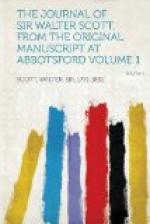origin of civilisation, proving that the sciences
have not sprung at once into light and life, but rose
gradually with extreme purity, and continued to be
practised best by those who first invented them.
Full of these reflections, we returned to our hospitable
Miss Whyte in a drizzling evening, but unassassinated,
and our hearts completely filled with the magnificence
of what we had seen. Miss Whyte had in the meanwhile,
by her interest at La Trinita with the Abbot, obtained
us permission to pay a visit to him, and an invitation
indeed to dinner, which only the weather and the health
of Sir William Gell and myself prevented our accepting.
After breakfast, therefore, on the 18th of March,
we set out for the convent, situated about two or
three miles from the town in a very large ravine,
not unlike the bed of the Rosslyn river, and traversed
by roads which from their steepness and precipitancy
are not at all laudable, but the views were beautiful
and changing incessantly, while the spring advancing
was spreading her green mantle over rock and tree,
and making that beautiful which was lately a blighted
and sterile thicket. The convent of Trinita itself
holds a most superb situation on the projection of
an ample rock. It is a large edifice, but not
a handsome one—the monks reserving their
magnificence for their churches—but was
surrounded by a circuit of fortifications, which, when
there was need, were manned by the vassals of the
convent in the style of the Feudal system. This
was in some degree the case at the present day.
The Abbot, a gentlemanlike and respectable-looking
man, attended by several of his monks, received us
with the greatest politeness, and conducted us to the
building, where we saw two great sculptured vases,
or more properly sarcophagi, of [marble?], well carved
in the antique style, and adorned with the story of
Meleager. They were in the shape of a large bath,
and found, I think, at Paestum. The old church
had passed to decay about a hundred years ago, when
the present fabric was built; it is very beautifully
arranged, and worthy of the place, which is eminently
beautiful, and of the community, who are Benedictines—the
most gentlemanlike order in the Roman Church.
We were conducted to the private repertory of the
chapel, which contains a number of interesting deeds
granted by sovereigns of the Grecian, Norman, and
even Saracen descent. One from Roger, king of
Sicily, extended His Majesty’s protection to
some half dozen men of consequence whose names attested
their Saracenism.
In all the society I have been since I commenced this
tour, I chiefly regretted on the present occasion
the not having refreshed my Italian for the purpose
of conversation. I should like to have conversed
with the Churchmen very much, and they seem to have
the same inclination, but it is too late to be thought
of, though I could read Italian well once. The
church might boast of a grand organ, with fifty-seven
stops, all which we heard played by the ingenious
organist. We then returned to Miss Whyte’s
for the evening, ate a mighty dinner, and battled cold
weather as we might.




